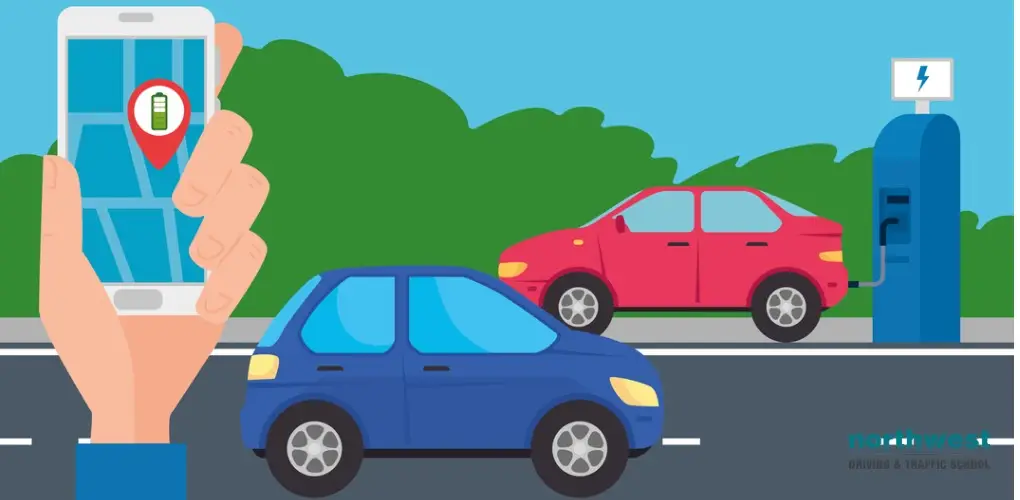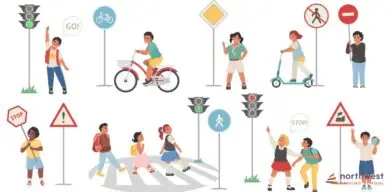- Traffic School
How To Drive A Vehicle

When you’re teaching your child how to drive, it can be very difficult for you to tell if they are developing good visual habits. Good visual habits are essential for safe driving. Here are some common errors that drivers make with poor visual habits:
- Do not prepare for stops or turns far enough in advance
- Do not notice traffic tie-ups in advance
- Become trapped behind large trucks, slow-moving vehicles, or
parked cars - Are frequently surprised
- Are unaware of their own speed
- Drive with turn signals flashing without intending to turn
- Drive with mirrors that are dirty or out of adjustment
- Become distracted easily
When learning to drive, there are two important habits we need to develop to become safe defensive drivers.
1. Looking ahead
Gives you time and space for decision making and vehicle control
How far ahead should we look?
- 2 blocks
- Drop back to 1 block (12 seconds)
- Drop back to 2-4 seconds
What benefit do we get by varying how far ahead we look?
- It allows your brain to correctly interpret the signal it receives from your eyes
2. Keep scanning
Scanning allows you to see all of the important information happening around your vehicle as you drive up your intended path of travel.
Ground scanning
- This will allow you to know when another vehicle may be about to change direction.
- It will allow you to see people standing in between parked cars and small kids playing near the street.
Let’s discuss the proper procedures for making a right turn. If you follow the steps outlined below, you will make a proper turn every time.
- Check traffic as you approach the intersection
- Activate your right turn signal at 100 feet
- Check your rearview mirror to make sure the vehicle behind you is not making the same maneuver.
- Check the passenger side mirror and check your blind spot
- Position your vehicle two feet from the curb (just to the left of the white gutter strip)
- As the front of your vehicle reaches the point where the curb starts to curve around, begin your turn
- Look to the right side of the windshield
- To complete your turn, look up in the middle of your new travel lane
- After completing your turn, check your rearview mirror and smoothly accelerate
Speed:
The hardest thing for new drivers to master is controlling their speed. Optimally, the driver will be 2-3 mph under the posted speed limit. Once you have reached your desired speed in accordance with the posted speed limit, follow these tips to stay at your current speed:
- Ease your foot off the gas pedal
- Apply slight pressure to the pedal to where you feel a slight pull in the back of your right leg.
Stopping:
Every time you stop your vehicle, three things must happen
- Perception distance- how far you travel in the time it takes your eyes to send a signal to your brain.
- Reaction distance- how far you travel in the time it takes your brain to signal your foot to get off the gas and move to the brake.
- Braking distance- how far you travel after you hit the brake until the vehicle stops.
- Adding up these distances will equal what we call your total stopping distance.
To avoid hard stops, keep the heal of your foot on the ground between the gas and the brake and pivot.
When stopped in traffic behind other vehicles, always stop back where you can see their back tires touching the ground.
Lane changes:
When changing lanes, always
- Signal 100 feet in advance
- Check your rear view mirror to ensure the vehicle behind you will not try and pass you.
- Check your outside mirror
- Check your blind spot
- Look up front and move your vehicle into its new lane
- It’s against the law to change lanes 100 feet before or after an intersection
A driver starting from a parked position must yield the right-of-way to all moving traffic and enter the traffic flow only when it is safe to do so.
Turns:
- All turns should be made lane-to-lane
- You can turn right on red if you come to a complete stop and there is no sign saying no turn on red.
- You can turn left on red if you turn from a 1-way street onto another 1-way street.
- When making a left turn on a green light or a flashing yellow arrow, you must yield the right of way to oncoming traffic and pedestrians.
If you have a left turn lane, check your rearview mirror to ensure the vehicle behind you is not making the same maneuver. Then, check the driver-side mirror and your blind spot before moving into the turn lane.



